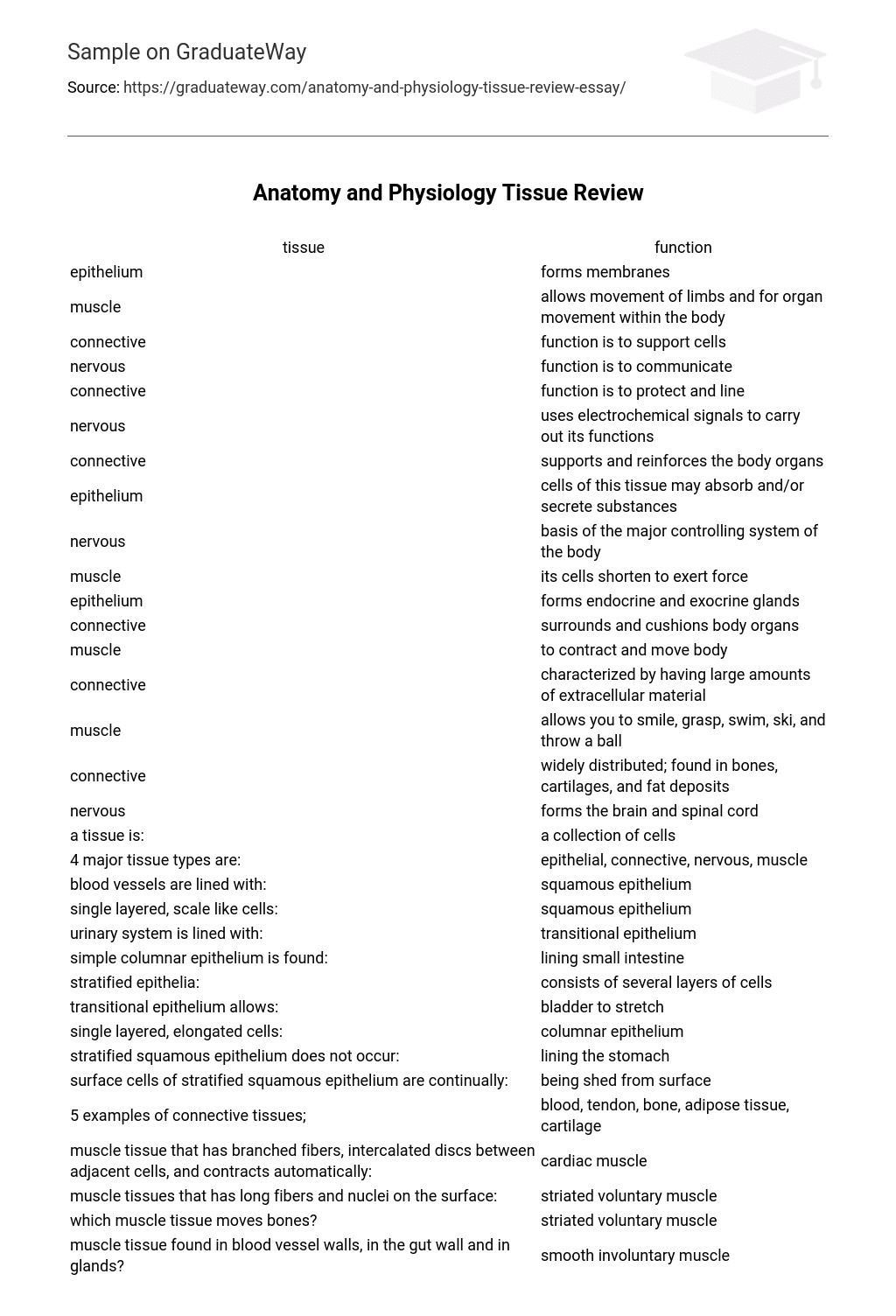| tissue | function |
|---|---|
| epithelium | forms membranes |
| muscle | allows movement of limbs and for organ movement within the body |
| connective | function is to support cells |
| nervous | function is to communicate |
| connective | function is to protect and line |
| nervous | uses electrochemical signals to carry out its functions |
| connective | supports and reinforces the body organs |
| epithelium | cells of this tissue may absorb and/or secrete substances |
| nervous | basis of the major controlling system of the body |
| muscle | its cells shorten to exert force |
| epithelium | forms endocrine and exocrine glands |
| connective | surrounds and cushions body organs |
| muscle | to contract and move body |
| connective | characterized by having large amounts of extracellular material |
| muscle | allows you to smile, grasp, swim, ski, and throw a ball |
| connective | widely distributed; found in bones, cartilages, and fat deposits |
| nervous | forms the brain and spinal cord |
| a tissue is: | a collection of cells |
| 4 major tissue types are: | epithelial, connective, nervous, muscle |
| blood vessels are lined with: | squamous epithelium |
| single layered, scale like cells: | squamous epithelium |
| urinary system is lined with: | transitional epithelium |
| simple columnar epithelium is found: | lining small intestine |
| stratified epithelia: | consists of several layers of cells |
| transitional epithelium allows: | bladder to stretch |
| single layered, elongated cells: | columnar epithelium |
| stratified squamous epithelium does not occur: | lining the stomach |
| surface cells of stratified squamous epithelium are continually: | being shed from surface |
| 5 examples of connective tissues; | blood, tendon, bone, adipose tissue, cartilage |
| muscle tissue that has branched fibers, intercalated discs between adjacent cells, and contracts automatically: | cardiac muscle |
| muscle tissues that has long fibers and nuclei on the surface: | striated voluntary muscle |
| which muscle tissue moves bones? | striated voluntary muscle |
| muscle tissue found in blood vessel walls, in the gut wall and in glands? | smooth involuntary muscle |
| epithelial | consists of many cells with little intercellular substance(matrix) |
| connective | penetrated by blood vessels (vascular) |
| connective | does not cover body surfaces or line passageways and cavities, but is more internally located; binds, supports, protects |
| fibrous | found where strength and rigidity are needed, as in discs between vertebrae and the symphysis pubis |
| hyaline | white, glossy cartilage covering ends of bones (articular), covering ends of ribs (costal), and giving strength to nose, larynx and trachea |
| elastic | provides strength and flexibility, as in external part of the ear |
| tissue forming walls of heart | cardiac |
| attached to bones | skeletal |
| spindle-shaped cells with ends tapering at points | smooth |
| contain intercalated discs and gap junctions | cardiac |
| found in walls of intestine, urinary bladder, and blood vessels | smooth |
| cells are multinucleate | cardiac |
| now i know my abcs | next time wont you sing with me |
Anatomy and Physiology Tissue Review
Cite this page
Anatomy and Physiology Tissue Review. (2017, Nov 16). Retrieved from
https://graduateway.com/anatomy-and-physiology-tissue-review-essay/





